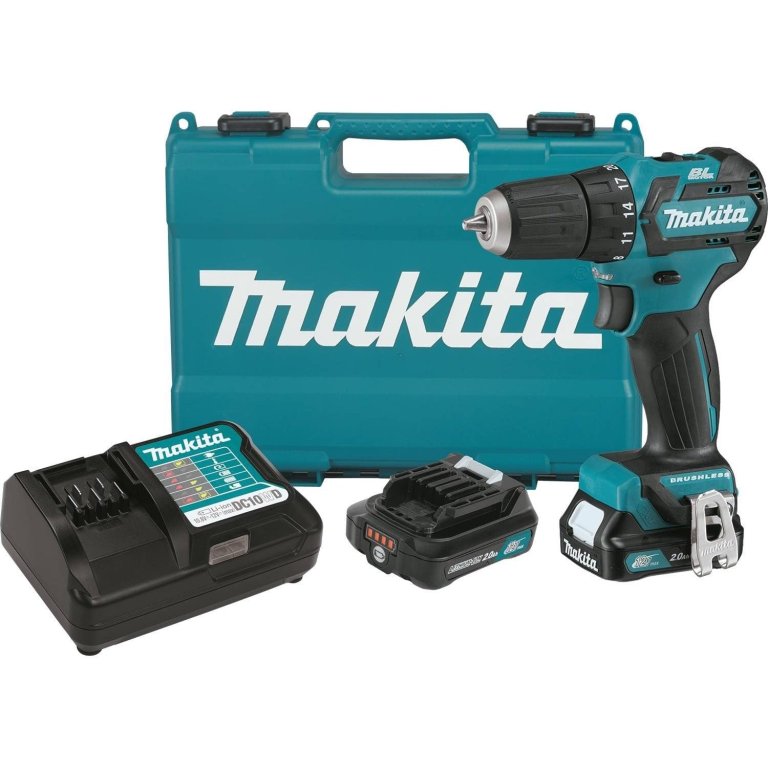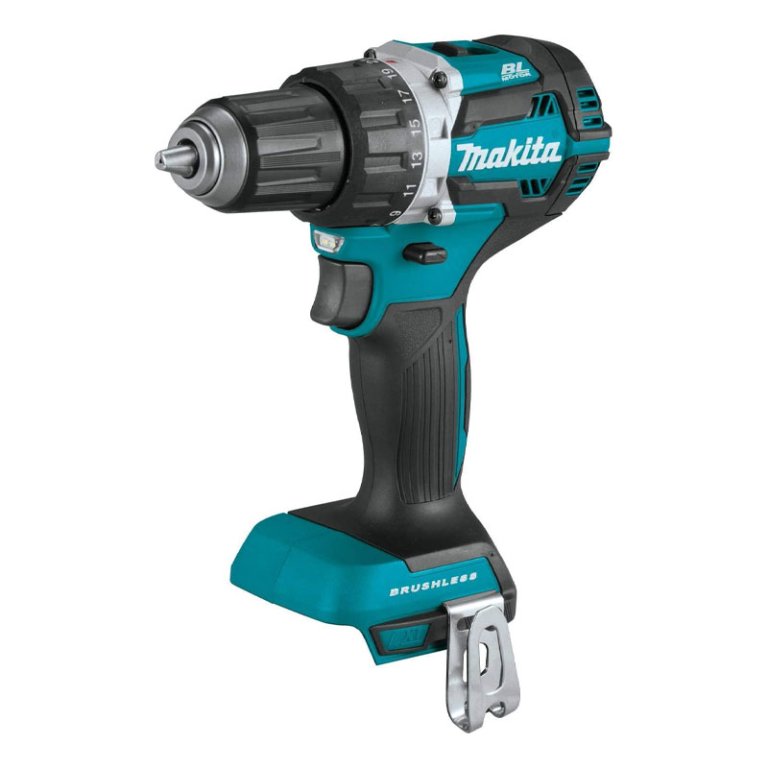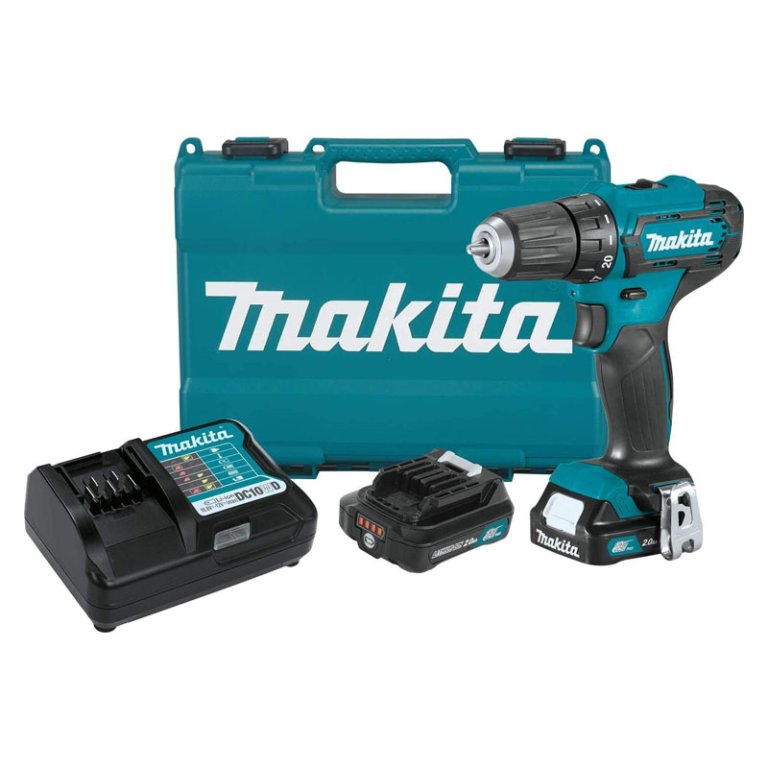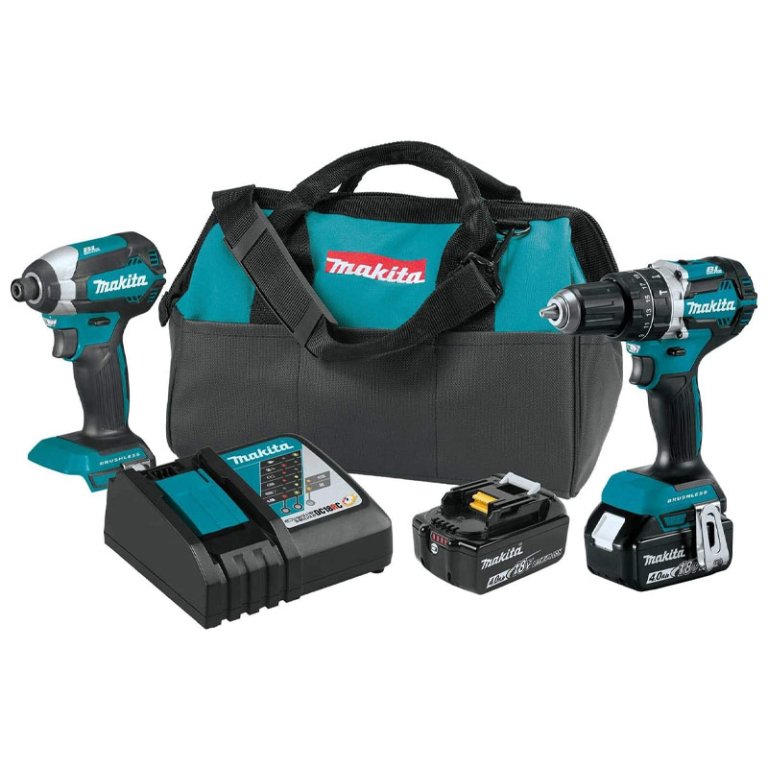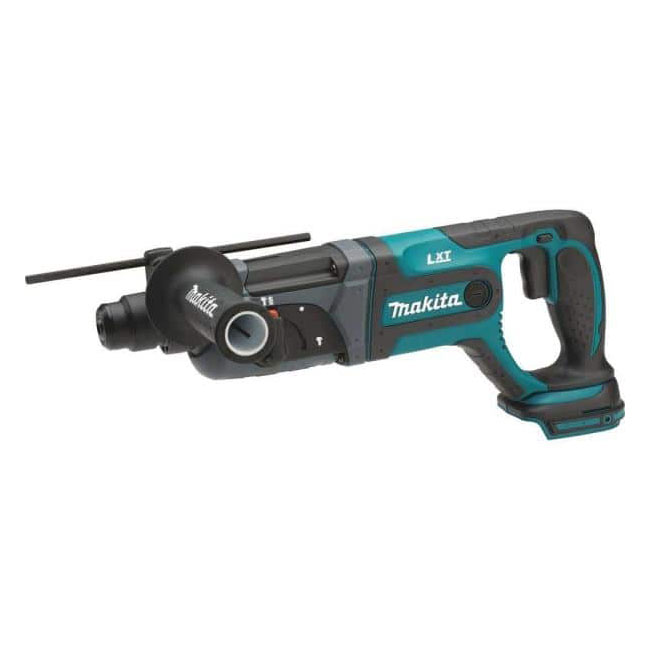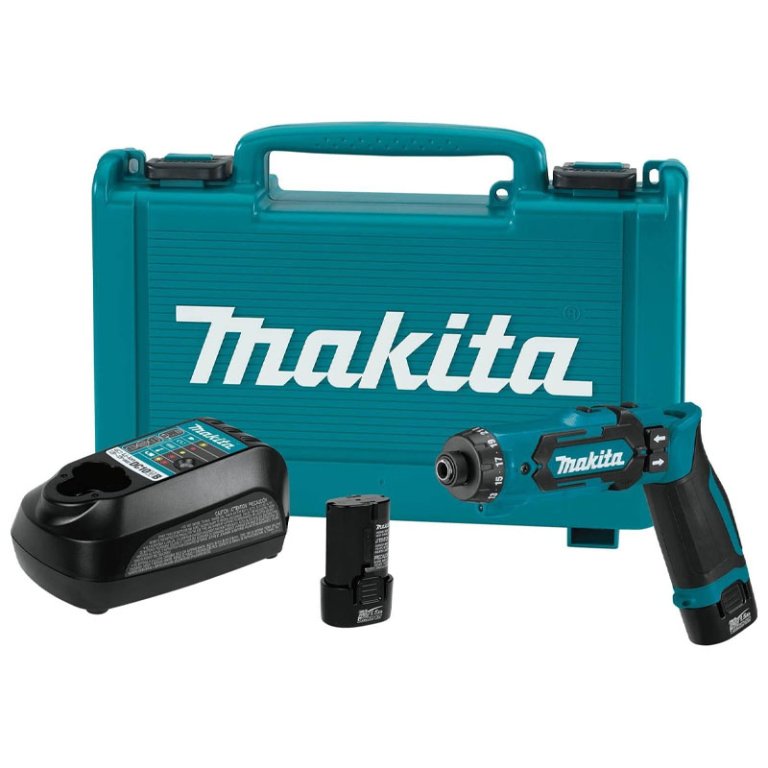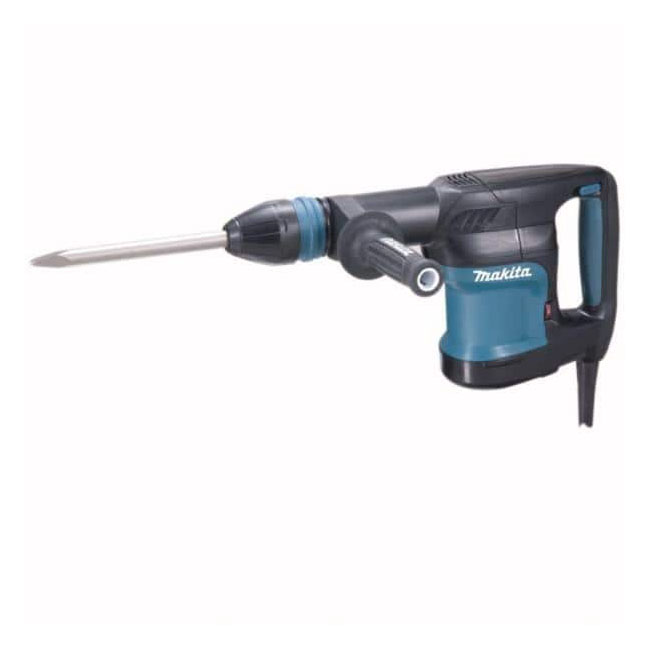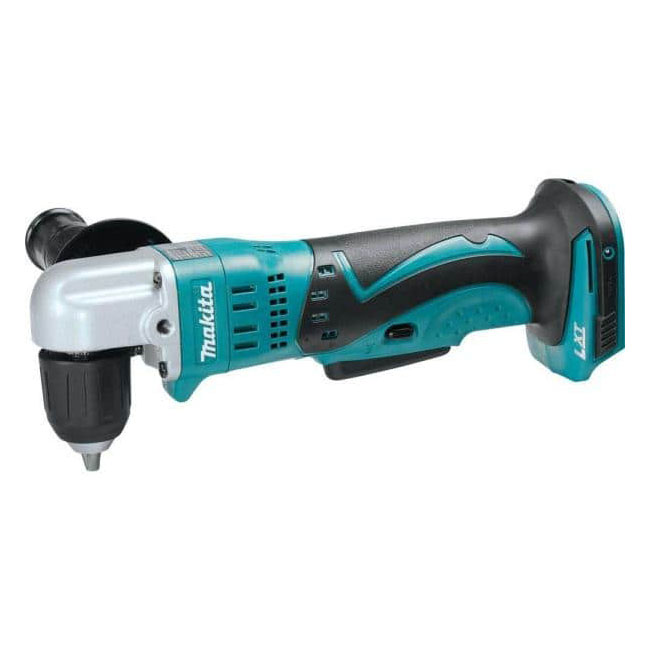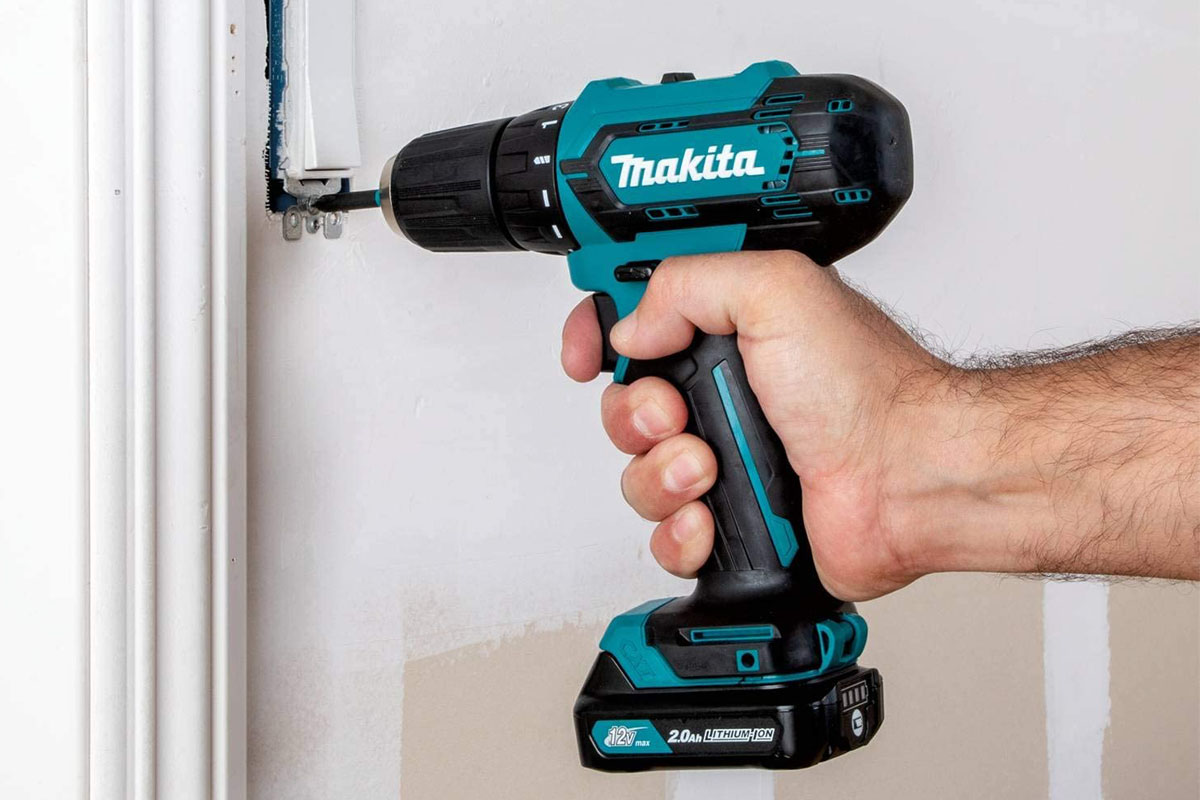
We may earn revenue from the products available on this page and participate in affiliate programs. Learn More ›
Makita drills are highly regarded for their competitive performance and excellent durability. The collection is also remarkably extensive, with over 60 models available from lightweight drill/drivers to heavy-duty demolition hammers. Having so many Makita drills available is great, but while any model is a solid choice, it can be challenging to decide which offers the optimal mix of power and features.
We tapped Brandon Walker, construction manager at ASAP Restoration LLC in Tempe, Arizona, for advice on how to choose the right drill for the job. We also tested several top picks to make sure they met our demands. Our favorite is the Makita FD07R1 12-Volt Brushless Cordless Driver-Drill Kit, which manages to be powerful enough to handle most jobs around the house while remaining compact and lightweight.
Read on to find out what you’ll want to consider when shopping for the best Makita drills and find out which ones are the brand’s top models.
- BEST OVERALL: Makita FD07R1 12V Brushless Cordless Driver-Drill Kit
↓ Jump to Review - RUNNER-UP: Makita XFD12Z 18V LXT Cordless Driver Drill
↓ Jump to Review - BEST BANG FOR THE BUCK: Makita FD09R1 12V MAX CXT Cordless Driver Drill Kit
↓ Jump to Review - BEST COMBO: Makita XT269M 18V LXT Brushless Cordless Combo Kit
↓ Jump to Review - BEST ROTARY HAMMER: Makita XRH04Z 18V LXT Cordless Rotary Hammer Drill
↓ Jump to Review - BEST 1/4-INCH DRILL DRIVER: Makita DF012DSE 7.2V Cordless Hex Driver Drill Kit
↓ Jump to Review - BEST SDS MAX HAMMER DRILL: Makita HM0870C SDS-MAX Demolition Hammer
↓ Jump to Review - BEST ANGLED DRILL: Makita XAD02Z 18V LXT Cordless Angle Drill
↓ Jump to Review
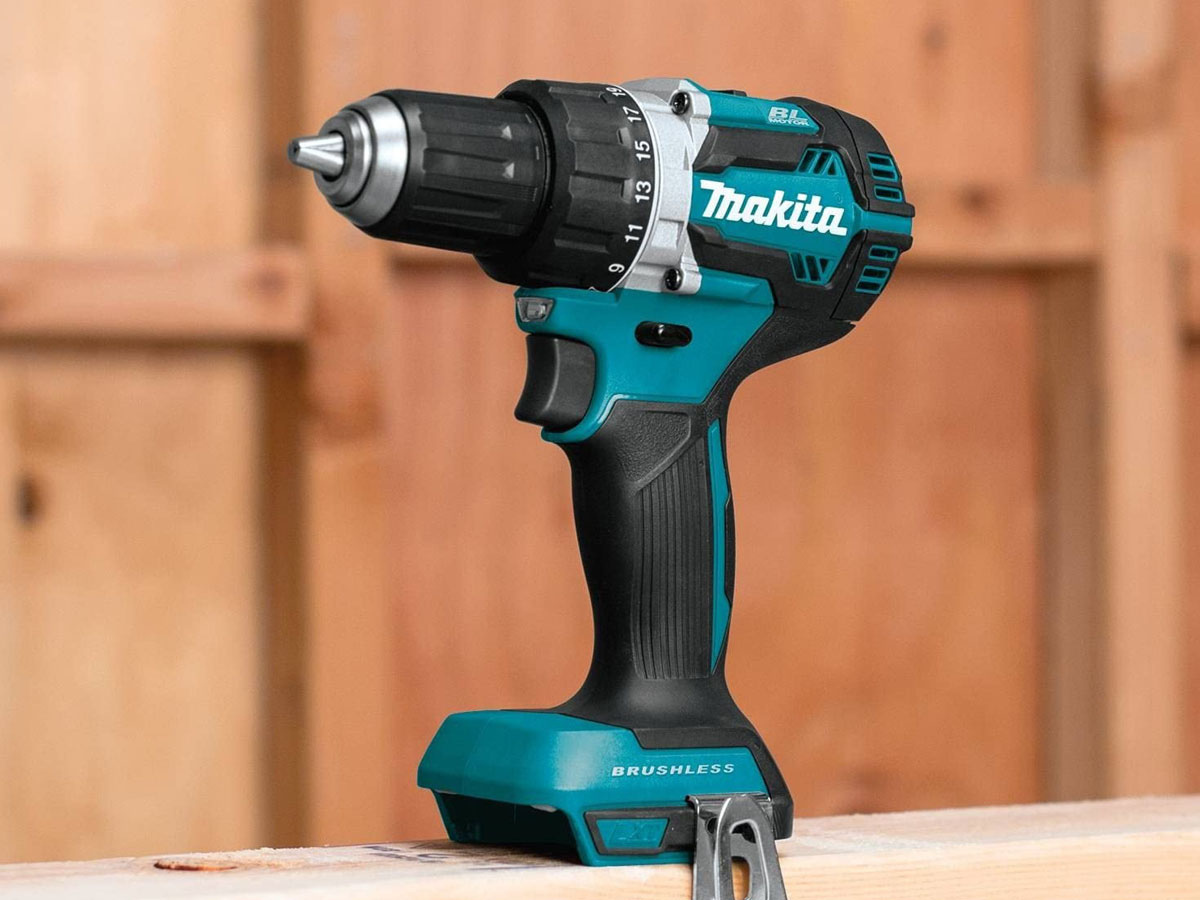
How We Chose the Best Makita Drills
Normally, BobVila.com pits products from different tool brands against each other in order to identify our top picks; see the best cordless drills, for example. Clearly, when looking for the best Makita drills, we’re dealing with the same manufacturer. So the tools aren’t in competition as such.
However, as we mentioned, the Makita drills range is huge and it isn’t always easy to differentiate between the models. What we have tried to do is pick out the best performers in a variety of categories, taking into account the criteria discussed in our considerations section above.
Along with comparing specs and scouring through customer reviews, we tested several of the top models to make sure they were up to snuff. For those drills we tested ourselves, we put them through a series of tests, drilling holes of various sizes and driving different types of fasteners.
The resulting top picks are a variety of different Makita drills that offer solutions to all kinds of job challenges and will appeal to a wide range of users.
Our Top Picks
The following are what we feel are the best Makita drills to tackle a wide range of tasks. They include a variety of different drill types that represent the best of what this premium brand has to offer.
Best Overall
Makita FD07R1 12V Brushless Cordless Driver-Drill Kit
What We Liked
- Brushless motor adds power, battery life, and durability
- Compact size and lightweight
- Surprisingly powerful for 12V drill
What We Didn’t Like
- Pricey for a 12-V drill
Product Specs
- Voltage: 12 volts (V)
- Chuck: 3/8 inch
- Speed: Up to 1,500 revolutions per minute (RPM)
Pick up the Makita FD07R1 and you’ll immediately notice its compact size and light weight. It measures just 6.5 inches long and weighs a hair over 2 pounds. This not only made Makita’s 12V drill easy to handle during testing but also allowed us to fit it into tighter spaces than its larger 18V brethren.
No, this 12V drill won’t rival the bigger motors on larger drills, but it’s certainly no slouch. We drilled dozens of holes on a single charge, and we didn’t just stick to small drill bits. Set to a lower speed to maximize torque output, it capably handled a paddle bit and hole saw.
We experienced similar performance with various size screws. We found that as long as we made adjustments to speed and torque settings, the FD07R1 could handle larger fasteners.
We were also impressed with battery life. The Makita didn’t start petering out until after 35 minutes of near continuous drilling and driving. Not bad for such a lightweight drill. This Makita drill set won’t quite match the speed and power of 18V models, but it boasts enough power to handle most household projects.
Get the FD07R1 Makita drill at Amazon or The Home Depot.
Runner-Up
Makita XFD12Z 18V LXT Cordless Driver Drill
What We Liked
- Renowned build quality and durability
- High-efficiency brushless motor
- 530 inch-pounds (in-lbs) of torque
What We Didn’t Like
- Battery and charger cost extra
- LEDs could be more focused
Product Specs
- Voltage: 18V
- Chuck: ½ inch
- Speed: 2 speeds: 0 to 500 RPM and 0 to 2,000 RPM
With so many high-quality tools in the range, picking a single model as the best Makita drill is a challenge, but we eventually chose the Makita 18V LXT drill driver because it is an all-around high-performance tool that suits both DIY enthusiasts and tradespeople.
The Makita XFD12Z is compact for an 18V drill driver, at just 6¾ inches long. It weighs only 3.4 pounds and takes a 2.0Ah battery (not included). The soft grip also makes it comfortable to use and easy to handle. The high-efficiency brushless motor provides two speed ranges for increased versatility, and with 530 in-lbs of torque, it can tackle demanding drilling and driving jobs around the home or job site. Some 20 different clutch settings allow screwdriving power to be adjusted to suit large or small fixings with little chance of damage.
This model includes dual LEDs with afterglow, which means the light stays on for several seconds after the trigger is released so work can be checked. It’s a useful feature, and the LEDs provide decent light, but more focus on the chuck and drill bit area instead of the current wide beam would be an improvement.
Get the XFD12Z Makita drill at Amazon, or The Home Depot.
Best Bang for the Buck
What We Liked
- Among the lightest at just 2.4 pounds
- 250 in-lbs of torque
- Kit includes battery, charger, and hard case
What We Didn’t Like
- Professionals will want 18V power
- Could be more compact
Product Specs
- Voltage: 12V
- Chuck: ⅜ inch
- Speed: 2 speeds: 0 to 450 RPM and 0 to 1,700 RPM
Cordless 12V drill drivers lack the outright power of their 18V counterparts and are often seen as the best drill for home use. In this category, the Makita 12V CXT has just the right balance of weight and performance.
At 2.4 pounds, it is among the lightest drills in its class and is easy to maneuver. Somewhat surprisingly, at just 7 inches long, it is actually ¼ inch bigger than the more powerful 18V model. However, it is no larger than most competitors.
The brushless motor provides two speed ranges that are only slightly slower than the 18V Makita and perfect for household tasks. The 20-position clutch offers good versatility for driving. An LED worklight is built in. With an 18V battery, rapid charger, and a hard case included, it adds up to a high value package that is difficult to fault.
Get the FD09R1 Makita drill at Amazon, Ace Hardware, or The Home Depot.
Best Combo
Makita XT269M 18V LXT Brushless Cordless Combo Kit
What We Liked
- Powerful pro-standard combination
- Efficient brushless motors
- Includes 4.0-amp-hour (Ah) batteries and charger
What We Didn’t Like
- Cloth storage bag
Product Specs
- Voltage: 18V
- Chuck: ½ inch
- Speed: Drill: 0 to 500 RPM and 0 to 2,000 RPM. Impact driver: 0 to 3,400 RPM and 0 to 3,600 inches per minute (IPM)
The Makita hammer drill and impact driver combination will appeal to both professionals and keen amateur remodelers. Both are high-performance tools with brushless motors that maximize the battery power available. The kit includes Makita’s rapid charger and two 4.0 Ah lithium-ion batteries so there will be little or no downtime.
The Makita 18V LXT brushless combo drill is based on our runner-up pick, the two-speed Makita XFD12Z, with the addition of a hammer action for drilling brick, block, concrete, and so on. It is slightly heavier but still only 4.2 pounds with the battery attached. With a maximum speed of 3,400 RPM, the impact driver is very fast, with 1,500 in-lbs of torque to drive large screws and heavy-duty fixings with minimal effort. It weighs just 3.3 pounds.This impressive Makita combination of an LXT combi drill and impact driver is a considerable investment, but when compared to leading competitors, they are very competitively priced.
Get the XT269M Makita drill at Amazon, Tractor Supply Co., or The Home Depot.
Best Rotary Hammer
Makita XRH04Z 18V LXT Cordless Rotary Hammer Drill
What We Liked
- Comparatively light at 7.7 pounds
- Clever clutch prevents gear damage
- Auxiliary handle and depth gauge
What We Didn’t Like
- No battery or charger
- Brush motor
Product Specs
- Voltage: 18V
- Chuck: ⅞ inch that accepts SDS-Plus bits
- Speed: 0 to 1,200 RPM and 0 to 4,000 BPM
Makita’s 18V rotary hammer drill is largely aimed at professional users, though its competitive price and relatively low weight will also make it of interest to DIY users looking for the best cordless hammer drill for a variety of tasks. It is a versatile tool capable of heavy-duty drilling in concrete and masonry, and because it can accept SDS-Plus bits it can also be used for light demolition.
The drill has three modes: rotation only for drilling in wood or other comparatively soft materials, rotation and hammer for drilling concrete, and hammer only for chiseling. Each is selected via a clear, easy-to-use dial. A torque-limiting clutch can sense if the drill bit binds and will temporarily disengage the drive. This not only protects the gearing from damage but also helps prevent nasty wrist injuries caused by sudden rotation of the tool when a bit jams.
The two-finger trigger has plenty of space for gloved hands. The shock absorber built into the handle both increases comfort and prevents vibration from damaging the battery. An auxiliary handle is provided to allow for a secure hold of this powerful drill, and a depth gauge is included.
Get the XRH04Z Makita drill at Amazon or The Home Depot.
Best 1/4-Inch Drill Driver
Makita DF012DSE 7.2V Cordless Hex Driver Drill Kit
What We Liked
- Use straight or pistol-grip
- 71 in-lbs torque
- 21 clutch settings
What We Didn’t Like
- Uses hex bits
Product Specs
- Voltage: 7.2V
- Chuck: ¼-inch hexagonal
- Speed: 2 speeds: 0 to 200 RPM and 0 to 650 RPM
While ⅜-inch and ½-inch Makita drill drivers offer plenty of versatility, there are times a more compact and lightweight tool has advantages. After test-driving the ¼-inch Makita drill driver, we found it to be perfect for many furniture assembly jobs or when maximum control is needed for drilling with smaller bits.
That shouldn’t suggest this drill is underpowered; far from it. The efficient brushless motor offers two speeds and up to 71 in-lbs of torque, which is impressive for a tool that weighs just 1.2 pounds. It won’t rival Makita’s 18V line of cordless drills, nor is it meant to. It’s designed to drill small holes and do the work of a cordless screwdriver. Its 21 clutch settings and two speed settings made it easy to adjust torque settings and RPM for driving in various fasteners.
We also liked the convertible design that allowed us to change the screwdriver from pistol grip for max control to in-line for fitting into tight spots, such as when installing hinges and cabinet slides. The Makita gave us an ample 30 minutes of near continuous use off a single charge. A built-in LED work light was also handy for working in darker confines, such as inside a cabinet.
The Makita 7.2V cordless hex drill driver is pricy given the limits of its power, though it does include a battery, charger, and case.
Get the DF012DSE Makita drill at Amazon or The Home Depot.
Best SDS Max Hammer Drill
Makita HM0870C SDS-MAX Demolition Hammer
What We Liked
- High power-to-weight ratio
- Soft start maximizes control
- Multiple chisel angles
What We Didn’t Like
- Considerable investment
- No drilling function
Product Specs
- Voltage: Corded; 120V
- Chuck: SDS Max, 18mm
- Speed: 1,100 to 2,650 blows per minute (BPM)
Strictly speaking, the Makita HM0870C demolition hammer is not a drill at all. Although it has a similar physical configuration to several of Makita’s rotary hammers, this model has no rotary action. It is all about delivering the impact necessary for effective demolition without the weight associated with heavy-duty jackhammers.
This is particularly important when horizontal work is required, and the Makita demolition hammer weighs just 11 pounds. Despite that, it delivers an impressive maximum of 2,600 BPM and impact energy of 8.4 ft-lbs. This is not a torque figure, but rather the energy with which it drives the chisel bits. It is sometimes given as joules (J), and in this case is 11.4J.
The Makita SDS Max demolition hammer also incorporates some very user-friendly features. The brush motor is common to tools of this type, but Makita’s has a service light to warn that the brushes need changing 8 hours in advance. There is an indicator for switch faults (which can be a problem in very dusty environments) or cord damage. A chisel bit can be set in 12 different positions so the operator doesn’t need to hold the tool at awkward angles. It also has a soft start, so this powerful tool doesn’t jump suddenly in the user’s hands.
Get the HM0870C Makita drill at Amazon or The Home Depot.
Best Angled Drill
Makita XAD02Z 18V LXT Cordless Angle Drill
What We Liked
- Reaches where ordinary drills cannot
- 121 in-lbs of torque
- Auxiliary handle
What We Didn’t Like
- Battery and charger extra
- Brush motor
Product Specs
- Voltage: 18V
- Chuck: ⅜ inch
- Speed: 0 to 1,800 RPM
Even Makita’s sub-compact drills have limits when it comes to fitting into confined spaces. Its 18V LXT cordless angled drill driver is often the solution. The compact head is only 3½ inches across, and the slim 12⅜ -inch body offers plenty of reach.
One-handed drilling and driving can be challenging, particularly when some pressure is required. Makita provides a short auxiliary handle for increased control where space allows. The Makita angled drill uses a brush motor, which, although reliable, does drain batteries more quickly than brushless. Unfortunately there isn’t room for a multiposition clutch, so more user control is required when driving screws. An LED light is included.
The Makita angled drill is not a budget tool, but for those who regularly need to work in cramped locations, it offers good power, excellent control, and Makita’s renowned durability.
Get the XAD02Z Makita drill at Amazon or The Home Depot.
Jump to Our Top Picks
What to Consider When Choosing a Makita Drill

While choosing the right type of Makita drill is one key element, it is not unusual to find two or three models within the range that look very similar on the surface. Other elements will be important in deciding which is the better choice, so the following features should be taken into account.
Types of Makita Drills
Given the enormous range of Makita drills available, it is worth taking a few moments for a quick overview of the various types of drills and the categories they fall into. This will help narrow down the search when looking for the best power drill for different home and workplace challenges.
Drill Driver
Drill drivers are undoubtedly the largest category, and because of their versatility, they are generally the most popular tool for both DIY users and professionals.
“Reliable, versatile, and compact,” Walker says of drill drivers. “These are great for drilling holes through most materials, and even putting in screws and other fasteners.”
Makita drill drivers range from a lightweight 7.2V model that folds in the middle, to lightweight 12V tools ideal for use at home, to powerful 18V drill drivers that deliver enough performance for the most demanding professional.
Regardless of size, all Makita drill drivers offer forward and reverse drive, and most have clutches that allow precise control of fastening force to prevent over-tightening or damage to surfaces. Several offer a choice of speeds, and we will look at the benefits of this in a moment.
Hammer Drill
This type of drill offers a form of hammer action that makes it easier to drill into hard surfaces. These combi drills combine the abilities of a drill driver with hammer action ability.
“A hammer drill combines the hammering action of a jackhammer with the torque of a high-end drill, and brings them both to bear on a single point of contact,” Walker says. “Typically hammer drills are used to bore into extremely hard and dense materials like concrete, brick, or stone.”
However, size and impact energy vary considerably.
The smallest Makita hammer drill is called a “sub-compact.” It is just 6½ inches long and weighs a fraction over 3 pounds. The standard model is larger and heavier but delivers increased torque. Torque is turning force, which is measured in inch pounds (usually written as in-lbs). Heavy-duty models are called SDS (slotted drive system). The term actually describes the chuck, which is a push-fit mechanism rather than the three-jaw type seen on drill drivers and ordinary hammer drills.
SDS drills can be called hammer drills, rotary hammers, or demolition hammers. In addition to drill bits that can be up to a couple of feet long, chisels can also be fitted. The motor can be switched over to hammer-action only, thus creating an efficient demolition tool. There are three types of SDS: SDS, SDS Plus, and SDS Max. SDS and SDS Plus drills have bits with 11mm shafts, but the latter has four splines instead of two and provides a more secure grip. SDS Max drills use 18mm diameter shafts and are the most powerful of the SDS drills.
Impact Driver and Impact Wrench
Impact drivers, sometimes incorrectly referred to as impact drills, and impact wrenches are often confused because they share a similar name, though the differences are straightforward. An impact driver uses a hammer action, much like what you’d find with a hammer drill, but with a rotational rather than in-line motion. It is used to add extra torque to drive large screws like those used for decking, for example.
“One of the major benefits of an impact driver is that they have low incidents of cam out so that there is little chance they will strip your screws when putting them in or pulling them out too,” Walker says.
An impact wrench is not a drill at all but a powered wrench. Instead of a chuck, it has a square drive that takes hexagonal sockets. The most common use of impact wrenches is for removing and fitting lug nuts on wheels, and many people will recognize them as the tool that’s used when they have their tires changed. Sockets come in a wide range of sizes, and impact wrenches are used anywhere nuts and bolts need to be removed or tightened rapidly.
Power Screwdrivers
Powered screwdrivers are another tool lacking drill action, but they are worth mentioning because they have a variety of specific uses beyond the functionality provided by a standard drill driver.
Powered screwdrivers can be quite a simple tool—literally just a screwdriver with a motor to make turning screws easier. They can be particularly useful for those with reduced hand or wrist strength. However, there is a whole other category of professional powered screwdrivers. Some are used for rapid fixing of drywall screws, with a depth setting so the screw isn’t driven straight through the drywall. The other type takes collated screws on a long strip and can rapidly drive them one after another. Drywall screws can be used, but so can wood screws for fast fixing of flooring or paneling.
Corded or Cordless
All Makita drill drivers are now cordless, but corded power tools still have their place. Although the cord itself can be a little inconvenient and possibly pose a tripping hazard, a corded drill can run all day without interruption. Corded is sometimes the better choice for power-hungry tools like demolition hammers. This is particularly true of a heavy-duty SDS Max Makita cordless hammer drill, which either requires regular battery changes or causes time to be lost while batteries recharge. Makita corded drills also tend to be significantly cheaper than a Makita cordless drill.
That said, Makita’s lithium-ion battery technology is highly efficient; the company’s charges are among the fastest in the industry. Typical charge times are around 15 minutes for an entry-level 1.5 Ah battery, 30 minutes for a longer-lasting 3.0 Ah version, and around an hour for the range-topping 6.0 Ah model.
Note that batteries need to be the correct voltage for the tool. You cannot fit a 12V battery on an 18V tool or vice versa. However, you can use batteries with a higher or lower Ah rating. Higher Ah equates to a longer runtime for your Makita battery-powered drill, but they are more expensive.
Brushed or Brushless Motor
Brushed motors have been around since the invention of power tools. The brushes are used to transmit a positive or negative electrical charge that keeps the motor running. In doing so, they rub against part of the motor, causing friction. There are two side effects to this: heat buildup and a small loss of power.
A Makita brushless drill uses electronics to create virtual brushes. There are no points of contact, so no friction is created. Without the associated power loss, brushless motors allow cordless tools to run for between 30 and 50 percent longer from the same size battery. There is also no wear, so Makita’s brushless drill motors require no maintenance and are more durable.
Some Makita cordless drills still use brush motors because they provide considerable cost savings.
Speed
Makita drill speed, like almost all power drills, is mainly regulated by trigger control. While it is usually down to finger pressure, a number of Makita drills have two speed ranges to allow for easier control.
Maximum speed varies depending on the tool. Using larger drill bits demands more torque and less outright speed. So whereas Makita’s 18V drill drivers have a top speed of 2,000 RPM for rapid drilling, their SDS drills max out at 1,200 RPM.
Torque is also an important factor in driving screws and other fixings, so impact drivers typically have higher torque than standard drill drivers. These are figures that can not only be compared between Makita models, but also against rivals.
When comparing Makita hammer/SDS drills it’s also worth checking the BPM (blows per minute) or IPM (impacts per minute), which is the speed of the hammer action.
Size, Weight, and Chuck Jaws
Physical size can have an impact for those who regularly work in confined spaces. Makita’s 18V sub-compact drills are specifically designed for the purpose, though DIY users might opt for the 12V models, which don’t quite offer the same performance but are lighter and more affordable. For very tight areas, there are also Makita right-angle drills. Not to be confused with angle grinders, these drills are meant for one thing.
“[Right-angle drills] are designed with a head that is built at a right angle specifically for drilling into tight spaces or around corners,” Walker says. “There is really no use for an angle drill besides this application, but when it is a requirement, there isn’t anything else that will work as well.”
You can find out more about the brand’s top right-angle drill in our Makita right angle drill review.
Weight is a consideration for those who use a Makita drill for long periods or those with reduced physicality. The Makita 12V CXT drill driver weighs just 2.4 pounds with the battery, whereas the Makita 18V LXT weighs a pound more. The Makita SDS Max demolition hammer weighs 11 pounds. Though lighter than a leading competitor, it will be tiring to use all day.
We mentioned the use of three-jaw and SDS chucks a little earlier in the article. It is also of interest to note chuck size, which indicates the maximum shank it can accept and gives an indication of the power available. Lightweight Makita drill drivers can have a chuck as small as ¼ inch. Most DIY and light-duty professional tools are ⅜ inch. Heavy-duty drill drivers have a ½-inch chuck. SDS chucks are a fixed size with a push fit, rather than tightening like a three-jaw model.
Additional Features
- Some Makita drills have load-balancing technology that can sense if the drill is struggling and increase power accordingly.
- Many Makita drills have an LED light fitted, which is useful when working in dark corners.
- Makita hammer/SDS drills usually have an auxiliary handle for additional grip. They may also have a depth gauge fitted.
- A belt loop is a common extra on Makita drills.
- Makita rapid optimum chargers are not only fast but also have an automatic maintenance mode that prevents batteries from being damaged by overcharging.
- Bare tools offer the opportunity to save money on Makita drills if you already own a compatible battery and charger. If not, it’s worth exploring the various Makita combo options, which often offer very good value.
The Advantages of Owning a Makita Drill
Makita has been making power tools since 1958. It introduced its first cordless drill in 1978 and its first brushless model in 2004 (at the time only available to the defense and aerospace industries). The company introduced the world’s first 18V brushless impact driver in 2009. Few tool manufacturers have that kind of experience, and Makita drills invariably rank as either the best drill brand or runner-up (to DeWalt) in dozens of independent reviews for performance and reliability.
- The Makita drills range is extensive, from competitively priced DIY drill/drivers models to pro-grade demolition hammers.
- Makita drills have renowned reliability and durability.
- Makita batteries are known for their fast charging and long service life.
- Makita has had U.S. manufacturing and assembly since 1985, with highly rated customer support.
- The 18/36V LXT cordless range now includes over 250 different tools, and all of them can use the same batteries.
FAQs
The information and examples above should help you choose the best Makita drills for a variety of different jobs. During our research, we found a number of questions relating to batteries that crop up quite frequently, so we have provided answers for those here.
Makita is among the top tool brands in the business, renowned for its line of cordless tools. As a result, Makita tools also come with a premium price tag. The company’s cordless tool line includes its 40V XGT tools, 18V LXT tools, and 12V CXT line.
Makita’s drills are among the top performers, producing torque and speed that rivals the best drills in the business. The brand’s tools can be found in the arsenals of many pros along with DeWalt and Milwaukee.
There isn’t one particular tool that this brand is well known for. However, Makita is highly regarded for its cordless tools, including its circular saws, drills, drivers, and jigsaws. The company produces high-performance tools with some of the best rechargeable batteries in the business.
Yes. Leaving the battery on your Makita drill does no harm and will not drain the battery. However, it’s a good idea to remove them if you’re cleaning your power tools to avoid damaging them.
Makita recommends you use only genuine Makita batteries with your drill. However, converters may be available to allow other manufacturers’ batteries to be used.
Makita LXT batteries are interchangeable with the whole Makita LXT tools range of over 250 different tools. Likewise, Makita CXT batteries fit the whole CXT tool range of over 50 tools.
No. Makita lithium-ion battery chargers have a built-in sensor. Once the battery is fully charged, the charger switches to maintenance mode, which keeps the battery topped up and ready to use.
It depends on the Ah rating. The higher the capacity, the longer it will take to charge. Makita’s own figures state that a 1.5 Ah battery takes 15 minutes, whereas the 6.0 Ah version takes 60 minutes.



